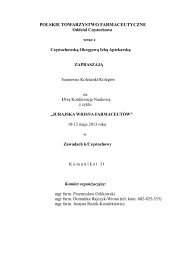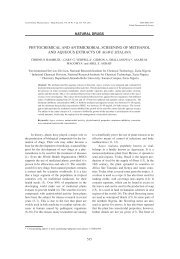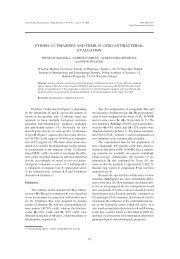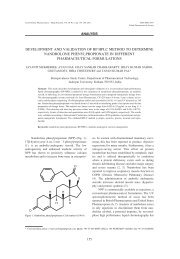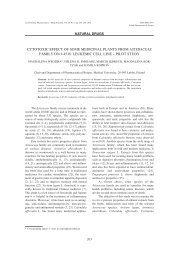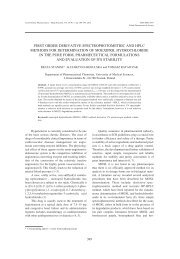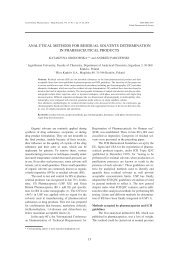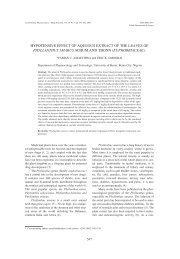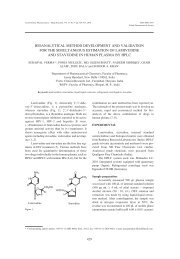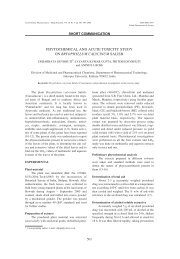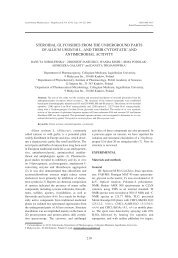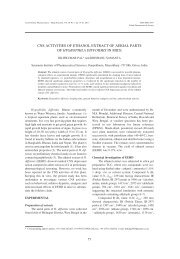FLAVONOIDS FROM PRUNUS SEROTINA EHRH.
FLAVONOIDS FROM PRUNUS SEROTINA EHRH.
FLAVONOIDS FROM PRUNUS SEROTINA EHRH.
Create successful ePaper yourself
Turn your PDF publications into a flip-book with our unique Google optimized e-Paper software.
Acta Poloniae Pharmaceutica ñ Drug Research, Vol. 62 No. 2 pp. 127ñ133, 2005 ISSN 0001-6837<br />
Polish Pharmaceutical Society<br />
NATURAL DRUG<br />
<strong>FLAVONOIDS</strong> <strong>FROM</strong> <strong>PRUNUS</strong> <strong>SEROTINA</strong> <strong>EHRH</strong>.<br />
MONIKA OLSZEWSKA*<br />
Department of Pharmacognosy, Faculty of Pharmacy, Medical University of £Ûdü,<br />
1 MuszyÒski Str., 90-151 £Ûdü, Poland<br />
Abstract: In the course of chemotaxonomic study of the genus Prunus, seven flavonol glycosides were isolated<br />
from the leaves of Prunus serotina Ehrh., characterized by UV and NMR spectroscopy, and identified finally<br />
as three quercetin monosides: hyperoside, avicularin, reynoutrin, three quercetin biosides: 3-O-(6î-O-α-Lrhamnopyranosyl)-β-D-glucopyranoside,<br />
3-O-(2î-O-α-L-rhamnopyranosyl)-β-D-glucopyranoside and 3-O-<br />
(2î-O-α-L-rhamnopyranosyl)-β-D-galactopyranoside as well isorhamnetin 3-O-(6î-O-α-L-rhamnopyranosyl)-<br />
β-D-glucopyranoside. The presence of determined flavonoids in the flowers was confirmed by TLC.<br />
Keywords: Prunus serotina Ehrh.; flavonoids; leaves; flowers; isolation; identification<br />
This paper presents the results of phytochemical<br />
analysis of the leaves and flowers of Prunus serotina<br />
Ehrh. as a part of the chemotaxonomic survey<br />
of the genus Prunus L. (Rosaceae) (1-5).<br />
Prunus serotina Ehrh. (American black<br />
cherry, bird cherry, virginian prune, rum cherry)<br />
represents the subgenus Padus, which contains<br />
only ca. 30 species, mainly native to continental<br />
climate areas (6). P. serotina, the largest of the<br />
native cherries, is a very fast growing tree indigenous<br />
to North America and planted, mainly in<br />
Europe, for timber and for ornamental purposes<br />
(handsome foliage) and locally naturalized (6,<br />
7). In Poland it occurs commonly, especially in<br />
lowlands on dry soils and in many forest cover<br />
types (8).<br />
Until the 90s of the 20 th century the virginian<br />
prune bark was used in the USA and British official<br />
pharmacy in the treatment of irritating coughs,<br />
bronchitis and asthma (mainly as the principal<br />
ingredient of wild cherry syrup, a popular<br />
vehicle for cough syrups), due to the presence of<br />
cyanogenic glycosides (9-10). The fruits of P. serotina<br />
are used in the USA in food industry as<br />
a flavouring agent for rum and brandy. Interestingly,<br />
the extracts of P. serotina show a significant<br />
antioxidant activity and, which has been revealed<br />
recently (11), may be used for antioxidant cosmetics<br />
production. However, except several studies<br />
of cyanogenic glycosides and cyanogenesis during<br />
development stages (12, 13), phytochemical<br />
investigations of the taxon to date have been<br />
fragmentary and there has been no systematic<br />
exploration of its polyphenolic components,<br />
especially flavonoids, which can be connected<br />
with the mentioned antioxidant activity. From<br />
polyphenols only three flavonols (quercetin, serotrin<br />
ñ probably quercetin 3-glucoside and an<br />
unidentified compound with metoxyl group)<br />
from the leaves (14), two anthocyanins (cyanidin<br />
3-glucoside and 3-rutinoside) (15, 16) accompanied<br />
by elagic acid (16) from the fruits and polymeric<br />
leucoanthocyanidins together with protocatechuic<br />
acid from the bark (17) were detected<br />
previously.<br />
The partial lack of knowledge about the polyphenols<br />
of this widely occurring plant with potential<br />
use has led to the following examination of the flavonoid<br />
components of P. serotina leaves and flowers.<br />
EXPERIMENTAL<br />
Plant material<br />
All samples of flowers (complete inflorescences:<br />
racemes) and leaves of Prunus serotina Ehrh.<br />
were collected in the Botanical Garden in £Ûdü, followed<br />
by air-drying in normal conditions and powdering.<br />
The leaves, collected in October 2001, were<br />
used for isolation, whereas the leaf and flower<br />
samples collected in Juni 2002 were the materials<br />
for cochromatographical analysis. Voucher specimens<br />
were deposited in the Department of Pharmacognosy.<br />
* e-mail ñ molszewska@pharm.am.lodz.pl, tel.: (+42)6779169, fax: (+42)6788398<br />
127
128 MONIKA OLSZEWSKA<br />
Equipment and methods<br />
Melting points (uncorrected) were determined<br />
on a Boetius apparatus. UV spectra with usual shift<br />
reagents (according to the standard procedure (18))<br />
were made with a Unicam 500 apparatus, 1 H and 13 C<br />
NMR were recorded on a Bruker spectometer DRX<br />
300 and 500 MHz (in DMSO-d 6 , TMS as int.<br />
standard).<br />
Preparative column chromatography (CC) was<br />
performed on a polyamide SC6 (Roth), silica gel 60<br />
(MN) and Sephadex LH-20 (Fluka); preparative<br />
TLC on polyamide 11 (Merck); analytical TLC on<br />
silica gel 60 precoated plates (Merck); PC on<br />
Whatman No 1. For TLC and PC the following<br />
solvent systems were employed:<br />
S-1: n-BuOH / AcOH / H 2 O (4:1:5, organic<br />
phase);<br />
S-2: 15% AcOH;<br />
S-3: EtOAc / HCOOH / H 2 O (18:1:1);<br />
S-4: n-BuOH / AcOH / HCOOH / H 2 O<br />
(100:27:1:5, organic phase);<br />
S-5: EtOH 96% / NH 4 OH 25% / H 2 O (20:1:4).<br />
Flavonoids were visualized by UV light 366 nm,<br />
with NH 3 fumes and by spraying with 1% AlCl 3 in<br />
MeOH, proanthocyanidins by spraying with 1%<br />
vanillin in 36% HCl (19). Sugars were detected by<br />
spraying with aniline phthalate solution in n-BuOH<br />
and heating at 105∞C.<br />
Extraction and isolation<br />
Powdered leaves of P. serotina (600 g) were<br />
preextracted with petrol followed by CHCl 3 in a Soxhlet<br />
extractor. Then, it was exhaustively extracted<br />
with boiling MeOH and 70% MeOH. Combined<br />
methanol extracts were evaporated, dissolved in water<br />
and partitioned between Et 2 O, EtOAc and n-Bu-<br />
OH. The Et 2 O extract (2.6 g) was submitted to CC<br />
on the polyamide (eluent: C 6 H 6 -MeOH with MeOH<br />
gradient) to yield five fractions: E-1 ÷ E-5. Fraction<br />
E-5 was rechromatographed in the same conditions<br />
and gave compounds I (150 mg) and II (85 mg), finally<br />
purified by crystallization from MeOH. The<br />
EtOAc (8.0 g) and n-BuOH (7.0 g) extracts were separately<br />
submitted to chromatographic gel filtration<br />
on Sephadex columns (using MeOH as eluent) to separate<br />
flavonoid and proanthocyanidins fractions.<br />
The EtOAc-flavonoid fraction was then first chromatographed<br />
on the polyamide (eluent: H 2 O-MeOH<br />
with MeOH gradient). Fractions eluted with 70-80%<br />
MeOH were next rechromatographed on silica gel<br />
(eluent: EtOAc-MeOH 9: 1) to afford four fractions:<br />
EA-1 ÷ EA-4. The EA-4 fraction, after crystallization<br />
from MeOH, gave compound III (700 mg). The<br />
flavonoid fraction obtained from the n-BuOH<br />
extract was first separated on the polyamide (eluent:<br />
C 6 H 6 -MeOH with MeOH gradient) to afford two<br />
fractions: B-1 and B-2. Fraction B-1 was purified on<br />
Sephadex (MeOH as eluent) to obtain compound<br />
IV (25 mg), whereas fraction B-2 was rechromatographed<br />
on the polyamide (eluent: H 2 O-MeOH with<br />
MeOH gradient 60-80%) and gave compounds<br />
V (52 mg), VI (with spuren of V and VII) and<br />
VII (48 mg). Compound VI (3.5 mg) was finally purified<br />
by preparative TLC on the polyamide in<br />
a two-step chromatographic procedure using first<br />
60%, and next 80% MeOH as a solvent system.<br />
Total acid hydrolysis<br />
1-3 mg of a glycoside was refluxed with 5%<br />
HCl for 2 h. The hydrolysate was extracted with<br />
Et 2 O and the obtained extract was washed with<br />
water, evaporated to dryness and resolved in<br />
MeOH. Identification of the aglycones was done<br />
by coPC (S-1) with standards of quercetin (R f<br />
0.78, isolated from Prunus spinosa (1)) and<br />
isorhamnetin (R f 0.85, obtained from Pyrus<br />
communis (20)). The remaining aqueous solution<br />
was evaporated to dryness, resolved in MeOH and<br />
the sugars were identified by coPC (S-1) and<br />
coTLC (S-5) with authentic standards of L-<br />
rhamnose (R f s: 0.31 (S-1), 0.57 (S-4)), D-glucose<br />
(R f s: 0.15 (S-1), 0.44 (S-4)) and D-galactose (R f s:<br />
0.13 (S-1), 0.36 (S-4)).<br />
Partial acid hydrolysis<br />
1-2 mg of diglycosides IV, V, VII and 2 mg<br />
of a mixture of V and VI (because of lack of pure<br />
VI) were refluxed with 5 mL MeOH and 1 mL<br />
15% AcOH for 15 min at 50∞C. The obtained monosides<br />
were identified in the hydrolysate by coTLC<br />
(S-3, S-4) with standards of isorhamnetin 3-O-β-<br />
-D-glucopyranoside (20), isoquercitrin (2) and hyperoside<br />
(III).<br />
QUERCETIN 3-O-α-L-ARABINOFURANOSIDE,<br />
AVICULARIN (I)<br />
Yellow prisms, m.p. 216-218∞C (MeOH); PC<br />
R f s: 0.82 (S-1), 0.36 (S-2); TLC R f 0.63 (S-3), 0.78<br />
(S-4). UV λ MeOH max nm: 256, 269sh, 300sh, 358; NaOMe<br />
271, 325, 406; AlCl 3 273, 307sh, 335sh, 434; AlCl 3 -<br />
HCl 269, 303sh, 362, 401; NaOAc 274, 323sh, 390;<br />
NaOAc-H 3 BO 3 262, 301sh, 376. 1 H NMR and 13 C<br />
NMR as in ref. (1).<br />
QUERCETIN 3-O-β-D-XYLOPYRANOSIDE, REY-<br />
NOUTRIN (II)<br />
Yellow needles, m.p. 227-231∞C (MeOH);<br />
PC R f s: 0.75 (S-1), 0.35 (S-2); TLC R f 0.44 (S-3),
Flavonoids from Prunus serotina Ehrh. 129<br />
0.60 (S-4); UV λ MeOH max nm: 257, 267sh, 300sh, 354;<br />
NaOMe 270, 326, 410; AlCl 3 274, 305sh, 335,<br />
436; AlCl 3 -HCl 270, 301sh, 362, 404; NaOAc<br />
268, 323sh, 394; NaOAc-H 3 BO 3 261, 268sh,<br />
303sh, 378. 1 H NMR (500 MHz) δ, ppm: 12.58<br />
(1H, s, OH-5), 7.54 (1H, d, J=1.9 Hz, H-2í), 7.51<br />
(1H, dd, J=1.9 and 8.5 Hz, H-6í), 6.82 (1H, d,<br />
J=8.5 Hz, H-5í), 6.37 (1H, d, J=1.9 Hz, H-8), 6.16<br />
(1H, d, J= 1.9 Hz, H-6), 5.31 (1H, d, J=7.3 Hz, H-<br />
1î), 3.60 (1H, dd, J=5.2 and 11.5 Hz, H-5î a ),<br />
3.20-3.45 (2H, m, H-3î and H-4î), 3.16 (1H, t,<br />
J=8.6 Hz, H-2î), 2.93 (1H, t, J=10.5 Hz, H-5î b ).<br />
13<br />
C NMR as in ref. (2).<br />
QUERCETIN 3-O-B-D-GALACTOPYRANOSIDE,<br />
HYPEROSIDE (III)<br />
Yellow needles, m.p. 222-226∞C (MeOH); PC<br />
R f s: 0.64 (S-1), 0.41 (S-2); TLC R f 0.27 (S-3), 0.41<br />
(S-4); UV λ MeOH max nm: 258, 268sh, 300sh, 362;<br />
NaOMe 272, 327, 412; AlCl 3 275, 307sh, 330, 435;<br />
AlCl 3 -HCl 269, 303sh, 366, 407; NaOAc 274,<br />
325sh, 410; NaOAc-H 3 BO 3 259, 298sh, 370. 1 H<br />
NMR (500 MHz) δ, ppm: 12.60 (1H, s, OH-5),<br />
7.63 (1H, dd, J=2.2 and 8.5 Hz, H-6í), 7.48 (1H, d,<br />
J=2.2 Hz, H-2í), 6.77 (1H, d, J=8.5 Hz, H-5í), 6.36<br />
(1H, d, J=1.9 Hz, H-8), 6.15 (1H, d, J=1.9 Hz, H-<br />
6), 5.34 (1H, d, J=7.7 Hz, H-1î), 3.61 (1H, d, J=3.2<br />
Hz, H-4î), 3.53 (1H, dd, J=8.0 and 9.3 Hz, H-2î),<br />
3.42 (1H, dd, J=5.6 and 10.1 Hz, H-6î a ), 3.22-3.34<br />
(3H, m, H-3î, H-5î and H-6î b ). 13 C NMR (75.5<br />
MHz) δ ppm: 177.56 (C-4), 164.11 (C-7), 161.23<br />
(C-5), 156.32 (C-2 i C-9), 148.35 (C-4í), 144.73<br />
(C-3í), 133.75 (C-3), 121.76 (C-6í), 121.28 (C-1í),<br />
116.20 (C-5í), 115.30 (C-2í), 103.92 (C-10),<br />
102.31 (C-1î), 98.65 (C-6), 93.53 (C-8), 75.74 (C-<br />
5î), 73.42 (C-3î), 71.28 (C-2î), 68.07 (C-4î),<br />
60.56 (C-6î).<br />
ISORHAMNETIN 3-O-(6î-O-α-L-RHAMNOPY-<br />
RANOSYL)-β-D-GLUCOPYRANOSIDE, ISOR-<br />
HAMNETIN 3-O-RUTINOSIDE, NARCISSIN (IV)<br />
Amorphous yellow powder, m.p. 194-199∞C;<br />
PC R f s: 0.55 (S-1), 0.58 (S-2); TLC R f 0.10 (S-3),<br />
0.20 (S-4); UV λ MeOH max nm: 255, 271sh, 322sh, 367;<br />
NaOMe 272, 328, 418; AlCl 3 268, 303sh, 362, 403;<br />
AlCl 3 -HCl 270, 300sh, 358, 403; NaOAc 280,<br />
328sh, 400; NaOAc-H 3 BO 3 255, 270sh, 303sh, 360.<br />
1<br />
H NMR δ, ppm: 12.56 (1H, s, OH-5), 7.84 (1H, d,<br />
J=1.7 Hz, H-2í), 7.50 (1H, dd, J=1.7 and 8.4 Hz, H-<br />
6í), 6.90 (1H, d, J=8.4 Hz, H-5í), 6.40 (1H, d, J=1.6<br />
Hz, H-8), 6.18 (1H, d, J=1.6 Hz, H-6), 5.42 (1H, d,<br />
J=7.2 Hz, H-1î), 4.40 (1H, s, H-1íî), 3.82 (3H, s,<br />
OMe-3í), 3.69 (1H, br d, J=11.0 Hz, H-6î a ), 0.96<br />
(3H, d, J=6.2 Hz, Me-6íî), 3.15-3.40 and 2.97-3.07<br />
(2×m, the remaining rutinosyl protons); 13 C NMR:<br />
see Table 1.<br />
QUERCETIN 3-O-(6î-O-α-L-RHAMNOPYRA-<br />
NOSYL)-β-D-GLUCOPYRANOSIDE, QUERCE-<br />
TIN 3-O-RUTINOSIDE, RUTIN (V)<br />
Amorphous yellow powder, m.p. 189-193∞C;<br />
PC R f s: 0.48 (S-1), 0.56 (S-2); TLC R f 0.07 (S-3),<br />
0.16 (S-4); UV λ MeOH max nm: 256, 266sh, 300sh, 360;<br />
NaOMe 272, 328, 410; AlCl 3 273, 303sh, 433; AlCl 3 -<br />
HCl 270, 300, 362, 401; NaOAc 275, 324sh, 392;<br />
NaOAc-H 3 BO 3 257, 303sh, 380. 1 H NMR δ, ppm:<br />
12.61 (1H, s, OH-5), 7.53 (2H, m, J=2.0 and 8.5 Hz,<br />
H-2í and H-6í), 6.84 (1H, d, J=8.2 Hz, H-5í), 6.38<br />
(1H, d, J=2.0 Hz, H-8), 6.19 (1H, d, J=2.0 Hz, H-6),<br />
5.34 (1H, d, J=7.3 Hz, H-1î), 4.38 (1H, s, H-1íî),<br />
7.70 (1H, br d, J=10.6 Hz, H-î a ), 0.99 (3H, d, J=6.2 Hz,<br />
Me-6íî), 3.15-3.41 and 3.05-3.10 (2×m, the remaining<br />
rutinosyl protons). 13 C NMR: see Table 1.<br />
QUERCETIN 3-O-(2î-O-α-L-RHAMNOPYRA-<br />
NOSYL)-β-D-GLUCOPYRANOSIDE, QUERCE-<br />
TIN 3-O-NEOHESPERIDOSIDE (VI)<br />
Amorphous yellow powder, m.p. 216-220∞C;<br />
PC R f s: 0.65 (S-1), 0.67 (S-2); TLC R f 0.11 (S-3),<br />
0.24 (S-4); UV λ MeOH max nm: 255, 264sh, 360; NaOMe<br />
274, 330, 414; AlCl 3 270, 300sh, 364sh, 423; AlCl 3 -<br />
HCl 270, 300, 358, 401; NaOAc 270, 393; NaOAc-<br />
H 3 BO 3 261, 303sh, 379. 1 H NMR δ, ppm: 12.62 (1H,<br />
s, OH-5), 7.57 (1H, dd, J=1.8 and 8.5 Hz, H-6í),<br />
7.53 (1H, d, J=1.8 Hz, H-2í), 6.85 (1H, d, J=8.5 Hz,<br />
H-5í), 6.42 (1H, d, J=1.1 Hz, H-8), 6.20 (1H, d,<br />
J=1.1 Hz, H-6), 5.50 (1H, d, J=7.3 Hz, H-1î), 5.08<br />
(1H, s, H-1íî), 3.73 (1H, br s, H-2íî), 3.60 (1H, br<br />
d, J=11.8 Hz, H-6î a ), 0.90 (3H, d, J=7.0 Hz, Me-<br />
6íî), 2.90-3.54 (m, the remaining sugar protons). 13 C<br />
NMR: see Table 1.<br />
QUERCETIN 3-O-(2-O-α-L-RHAMNOPYRANO-<br />
SYL)-β-D-GALACTOPYRANOSIDE (VII)<br />
Amorphous yellow powder, m.p. 209-214∞C;<br />
PC R f s: 0.53 (S-1), 0.75 (S-2); TLC R f 0.05 (S-3),<br />
0.14 (S-4); UV λ MeOH max nm: 259, 268sh, 300sh, 360;<br />
NaOMe 272, 328, 410; AlCl 3 274, 305sh, 332sh,<br />
435; AlCl 3 -HCl 269, 300sh, 364sh, 403; NaOAc<br />
274, 324, 390; NaOAc-H 3 BO 3 262, 300sh, 380. 1 H<br />
NMR δ, ppm: 12.70 (1H, s, OH-5), 7.72 (1H, dd,<br />
J=2.1 and 8.5 Hz, H-6í), 7.48 (1H, d, J=2.1 Hz, H-<br />
2í), 6.79 (1H, d, J=8.5 Hz, H-5í), 6.38 (1H, d, J=1.9<br />
Hz, H-8), 6.18 (1H, d, J=1.9 Hz, H-6), 5.63 (1H, d,<br />
J=7.7 Hz, H-1î), 5.06 (1H, s, H-1íî), 0.77 (3H, d,<br />
J=6.2 Hz, Me-6íî), 3.1-3.80 (m, the remaining sugar<br />
protons). 13 C NMR: see Table 1.
130 MONIKA OLSZEWSKA<br />
Table 1. 13 C NMR data for compounds IV-VII (δ, ppm, in DMSO-d 6 , at 125 MHz)<br />
Carbon IV V VI VII<br />
Aglycone<br />
2 157.30 156.55 156.52 156.56<br />
3 133.58 133.28 133.34 133.28<br />
4 177.92 177.32 177.40 177.64<br />
5 161.66 161.19 161.25 161.61<br />
6 99.39 98.69 98.84 99.04<br />
7 164.65 164.21 164.25 164.58<br />
8 94.51 93.57 93.68 93.79<br />
9 157.12 156.41 156.48 156.28<br />
10 104.63 103.89 104.12 104.21<br />
1í 121.67 121.14 121.33 121.45<br />
2í 113.75 115.21 115.36 115.49<br />
3í 147.48 144.74 144.85 145.24<br />
4í 149.85 148.42 148.53 148.74<br />
5í 115.82 116.23 116.38 115.93<br />
6í 122.99 121.56 121.33 122.52<br />
3í-OMe 56.29 - - -<br />
Sugar 3-glu 3-glu 3-glu 3-gal<br />
1î 101.70 101.19 98.79 99.15<br />
2î 74.77 74.06 77.42 76.03<br />
3î 76.85 76.44 77.12 74.43<br />
4î 70.69 69.98 70.48 68.91<br />
5î 76.31 75.89 77.05 75.33<br />
6î 67.55 66.97 60.85 60.49<br />
1íî 6î-rha 6î-rha 2î-rha 2î-rha<br />
101.43 100.72 100.83 100.85<br />
2íî 70.84 70.35 70.48 70.93<br />
3íî 71.11 70.54 70.48 71.05<br />
4íî 72.31 71.83 72.17 72.24<br />
5íî 68.84 68.22 68.30 68.51<br />
6íî 18.07 17.71 17.52 17.57<br />
TLC analysis of proanthocyanidins<br />
The proanthocyanidine fractions, isolated from<br />
EtOAc and n-BuOH extracts, were then analysed by<br />
TLC in S-3 solvent system (20) to reveal the presence<br />
of minimum twelve procyanidine compounds,<br />
characterized by the following R f values: 0.84, 0.81,<br />
0.71, 0.68, 0.65, 0.54, 0.43, 0.36, 0.30, 0.25, 0.17<br />
and 0.07. The mentioned components were present<br />
only in traces, with the exception of the compounds<br />
exhibited the R f s 0.84 and 0.71.<br />
Cochromatographic analysis of the flowers<br />
Samples (· 10 g) of the flowers and leaves<br />
(2002) were prepared similarly as described for the
Flavonoids from Prunus serotina Ehrh. 131<br />
isolation material to afford the MeOH extracts,<br />
fractionated between Et 2 O, EtOAc and n-BuOH.<br />
The obtained fractions were finally analysed by<br />
coTLC (S-2, S-3) with seven isolated compounds I-<br />
VII and by TLC (S-3) as a test of the presence of<br />
proanthocyanidins.<br />
RESULTS AND DISCUSSION<br />
Seven flavonol glycosides I-VII were isolated<br />
from the fractionated methanolic leaf extract of P.<br />
serotina by applying a combination of column chromatography<br />
on the polyamide, silica gel and Sephadex<br />
LH-20, followed by preparative thin layer chromatography<br />
on the polyamide.<br />
Compounds I-III showed chromatographic<br />
properties characteristic of monosides and upon acid<br />
hydrolysis released quercetin and sugars identified<br />
with L-arabinose, D-xylose and D-galactose, respectively.<br />
The UV spectra analysis indicated the site of<br />
glycosylation at position 3 in all cases (18). By the<br />
direct comparison (PC, TLC) with authentic standards<br />
of avicularin, reynoutrin (both isolated earlier<br />
from P. spinosa flowers (1, 2)) and hyperoside (isolated<br />
earlier from V. vitis idaea leaves (21)) and by<br />
the observed 1 H and 13 C NMR spectral data compound<br />
I was confirmed as quercetin 3-O-α-L-arabinofuranoside,<br />
avicularin, II as quercetin 3-O-β-D-xylopyranoside,<br />
reynoutrin and III as quercetin 3-O-β-<br />
-D-galactopyranoside, hyperoside (1, 2, 22-24).<br />
Compound IV was recognized as an isorhamnetin<br />
3-O-diglycoside from hydrolysis experiments,<br />
its chromatographic behaviour and UV spectral analysis<br />
(18). Thus, acid hydrolysis gave isorhamnetin,<br />
D-glucose and L-rhamnose. The controlled partial<br />
acid hydrolysis gave an intermediate isorhamnetin<br />
3-O-β-D-glucopyranoside, suggesting that IV is an<br />
isorhamnetin 3-O-rhamnosylglucoside. In the 1 H<br />
NMR spectrum, in addition to the signals of five<br />
aromatic protons and one metoxyl group of isorhamnetin,<br />
the presence of two sugar moieties was evidenced<br />
by the two proton signals: at d 5.42 ppm (doublet<br />
with diaxial coupling constant J 1,2 =7.2 Hz), assignable<br />
to the anomeric β-glucopyranosyl proton<br />
and at δ 4.40 (singlet), assignable to the anomeric α-<br />
-rhamnopyranosyl proton (22). In the 13 C NMR<br />
spectra, signals corresponding to the anomeric carbons<br />
were found at d 101.70 and 101.43 ppm, respectively.<br />
A downfield shift of Dd ca. 6.5 ppm of<br />
the C-6 glucosyl signal, accompanied by a minor<br />
(∆δ ca. 1.2 ppm) upfield shift of the C-5 glucosyl signal<br />
[in comparison to C-6 and C-5 glucosyl signals<br />
of quercetin 3-glucoside (2, 23)], proved that the terminal<br />
rhamnosyl moiety is attached to C-6 of the inner<br />
glucosyl moiety and indicated the sugar residue<br />
as rutinosyl (23, 25). The remaining signals in NMR<br />
spectra of IV were in close agreement with the proposed<br />
structure. Consequently, IV is identified as<br />
isorhamnetin 3-O-(6î-O-α-L-rhamnopyranosyl)-β-<br />
-D-glucopyranoside, narcissin (isorhamnetin 3-O-<br />
-rutinoside).<br />
Compound V was identified by chromatography<br />
(including direct comparison with the standard<br />
isolated earlier from Forsythia viridissima flowers<br />
(26)), hydrolysis results and spectral properties (UV,<br />
1<br />
H and 13 C NMR) as a quercetin analoque of IV,<br />
namely quercetin 3-O-rutinoside, rutin (18, 22, 23,<br />
25, 26).<br />
Compound VI exhibited chromatographic behaviour<br />
characteristic of a flavonol diglycoside and<br />
upon total and partial acid hydrolysis yielded the same<br />
components as V (quercetin, sugars and intermediate<br />
glycoside). The UV spectrum pointed to the<br />
glycosylation position at C-3 of quercetin only (18),<br />
and therefore indicated VI as a monodesmoside.<br />
The interglycosidic linkage in rhamnoglucosyl moiety<br />
was determined by NMR experiments. The 1 H<br />
NMR spectrum showed a singlet at δ 5.08 ppm, attributed<br />
to the anomeric α-rhamnopyranosyl proton<br />
and a doublet at δ 5.50 ppm (with diaxial coupling<br />
constant J 1,2 =7.3 Hz), assignable to the anomeric β-<br />
-glucopyranosyl proton (22) with chemical shift<br />
characteristic of glycosidation in a close position<br />
i. e., in C-2 position of the glucosyl residue [∆δ=0.5<br />
ppm, downfield shift in comparing with chemical<br />
shift of the anomeric proton signal in quercetin 3-<br />
glucoside (2, 22)]. In the 13 C NMR spectrum of<br />
VI the C-1 and C-2 carbon signals of the glucosyl<br />
moiety were observed at δ 98.79 and 77.42 ppm, respectively,<br />
which proved the suggested interglycosidic<br />
bond (1→2) by the recognizable downfield shift<br />
of the C-2 carbon signal (∆δ=3.3 ppm) and upfield<br />
shift of the C-1 signal (∆δ=2.1 ppm) in comparison<br />
with quercetin 3-glucoside (2, 23). Finally, the remaining<br />
signals in NMR spectra of VI were in close<br />
agreement with the indicated structure, quercetin 3-<br />
O-(2î-O-α-L-rhamnopyranosyl)-β-D-glucopyranoside,<br />
quercetin 3-O-neohesperidoside (27-29).<br />
Compound VII showed a similar UV, chromatographic<br />
and hydrolytic behaviour to VI, but D-galactose<br />
was detected instead of glucose. Analogically,<br />
its 1 H NMR spectrum supported a quercetin 3-O-<br />
-disaccharide with L-rhamnose as a terminal sugar.<br />
The anomeric protons resonances were observed at<br />
δ 5.06 (singlet), assignable to the α-rhamnopyranosyl<br />
and at δ 5.63 ppm (doublet, diaxial J 1,2 =7.7 Hz),<br />
assignable to the β-galactopyranosyl (22) with chemical<br />
shift characteristic of glycosidation in C-2 po-
132 MONIKA OLSZEWSKA<br />
sition of the galactosyl moiety (∆δ=0.3 ppm, downfield<br />
shift in comparing with chemical shift of the<br />
anomeric proton signal in III (quercetin 3-galactoside)).<br />
In the 13 C NMR spectrum of VII, the C-1 and<br />
C-2 carbon signals of galactosyl moiety were observed<br />
at d 99.15 and 76.03 ppm, respectively, which<br />
proved the suggested interglycosidic bond (1→2) by<br />
the downfield shift of the C-2 carbon signal (∆δ=4.8<br />
ppm) and upfield shift of the C-1 signal (∆δ=3.2<br />
ppm) in comparison with reference compound III.<br />
The remaining signals in NMR spectra of VII were<br />
in close agreement with the indicated structure, namely<br />
quercetin 3-O-(2î-O-α-L-rhamnopyranosyl)-<br />
β-D-galactopyranoside (30, 31).<br />
The presence of isolated compounds<br />
I-VII was then determined chromatographically by<br />
the comparative TLC and PC analysis in the<br />
fractionated methanolic extract of P. serotina<br />
flowers (inflorescences). The composition of<br />
flavonoid complexes of the leaves and flowers<br />
appeared to be very similar, consisted mostly of<br />
monosides and were especially rich in quercetin<br />
3-galactoside (hyperoside).<br />
All the described flavonoids have been isolated<br />
and characterized in taxon P. serotina for the first<br />
time.<br />
Flavonol 3-O-mono- and 3-O-diglycosides<br />
(mostly quercetin gluco-, galacto- and rhamnosides)<br />
occurs commonly in the genus Prunus (12).<br />
Interestingly, the leaves and flowers of the analysed<br />
taxon contain also quercetin pentosides (arabinoside<br />
and xyloside), similar to P. spinosa (1-3) and<br />
isorhamnetin 3-O-rutinoside, whose presence has<br />
been confirmed, to my knowledge, for the first time<br />
in the subgenus Padus.<br />
Apart from flavonoid compounds, the proanthocyanidine<br />
fraction has been isolated from P.<br />
serotina leaves and exhibited TLC chromatographic<br />
properties characteristic of leucoanthocyanidine<br />
dimers and oligomers (19), which are known<br />
as biologically active antioxidants (32), but their<br />
concentration in the studied material was significantly<br />
lower in comparison to flavonoids. The<br />
analogous proanthocyanidine fraction was next<br />
determined cochromatographically in the flowers.<br />
Finally, in the conducted study the flavonoids<br />
have been recognized as the main chemical components,<br />
which may be connected with expected antioxidant<br />
activity of P. serotina leaves and flowers.<br />
Acknowledgments<br />
The study is a part of the project No. 502-13-<br />
847 (198) of the Medical University of £Ûdü.<br />
REFERENCES<br />
1. Olszewska M., Wolbiú M.: Acta Polon. Pharm.<br />
ñ Drug Res. 58, 367 (2001).<br />
2. Olszewska M., Wolbiú M.: Acta Polon. Pharm.<br />
ñ Drug Res. 59, 133 (2002).<br />
3. Olszewska M., Wolbiú M.: Polish J. Chem. 76,<br />
967 (2002).<br />
4. Wolbiú M., Olszewska M., Weso≥owski W.J.:<br />
Acta Polon. Pharm. 58, 459 (2001).<br />
5. Olszewska M., Wolbiú M.: Herba Polon. 46,<br />
249 (2000).<br />
6. Rehder A.: Manual of cultivated trees and<br />
shrubs, hardy in North America exclusive of<br />
subtropical and warmer temperate regions.,<br />
Macmillan Company, New York 1947.<br />
7. Tutin T.G., Heywood V.H., Burges N.A.,<br />
Moore D.H., Walters S.M., Webb D.A.: Flora<br />
Europea, vol.2, University Press, Cambridge<br />
1968.<br />
8. Seneta W., Dolatowski J.: Dendrologia, PWN,<br />
Warsaw 2000.<br />
9. Osol A.(ed.): The Dispensatory of the United<br />
States of America, J.B. Lippincott, Philadelphia-Montreal<br />
1995.<br />
10. Martindale. The Extra Pharmacopoeia XXIX,<br />
The Pharmaceutical Press, London 1989.<br />
11. Golz-Berner K., Zastrow L.: PGT Int. Appl. NO<br />
2001026617A1, Patent, CA 134, 300647 g<br />
(2001).<br />
12. Hegnauer R.: Chemotaxonomie der Pflanzen,<br />
Bd. 6, Birkh‰user, Basel-Stuttgard 1973.<br />
13. Smeathers D.M., Gray E., James J.H.: Agron. J.<br />
65, 775 (1974).<br />
14. Power F.B., Moore C.W.: J.Chem. Soc. 97,<br />
1099 (1910).<br />
15. Ordaz-Galindo A., Wesche-Ebeling P.,<br />
Wrolstad R.E., Rodriguez-Saona L., Argaiz-<br />
Jamet A.: Food Chem. 65, 201 (1999).<br />
16. Goiffon J.-P., Brun M., Bourier M.J.: J.<br />
Chromatogr. 537, 101 (1991).<br />
17. Power F.B., Moore C.W.: J.Chem. Soc. 95, 243<br />
(1909).<br />
18. Mabry T.J., Markham K.R., Thomas M.B.: The<br />
Systematic Identification of Flavonoids,<br />
Springer, Berlin-Heidelberg-New York 1970.<br />
19. Kolodziej H., Sakar M.K., Burger J.F.W.,<br />
Engelshowe R., Ferreira D.: Phytochemistry 30,<br />
2041 (1991).<br />
20. RychliÒska I., Gudej J.: Acta Polon. Pharm. ñ<br />
Drug Res. 59, 53 (2002).<br />
21. Wolbiú M., KrÛlikowska M.: Polish J. Chem.<br />
64, 133 (1990).<br />
22. Markham K.R., Geiger H.: in The Flavonoids.
Flavonoids from Prunus serotina Ehrh. 133<br />
Advances in research since 1986, Harborne J.B.<br />
Ed., Chapman and Hall, Cambridge 1994.<br />
23. Markham K.R., Ternai B., Stanley R., Geiger<br />
H., Mabry T.J.: Tetrahedron 34, 1389 (1978).<br />
24. Zapesochnaya G.G.: Khim. Prir. Soedin. 15, 21<br />
(1979).<br />
25. Bylka W., Mat≥awska I.: Acta Polon. Pharm.<br />
ñ Drug Res. 56, 249 (1999).<br />
26. Tokar M., Klimek B.: Acta Polon. Pharm.<br />
ñ Drug Res. 61, 191 (2004).<br />
27. Dauguet J.-C., Bert M., Dolley J., Bekaert A.:<br />
Phytochemistry 33, 1503 (1993).<br />
28. Vidal-Ollivier, Elias R., Faure F., Babadjamian<br />
A., Crespin F., Balansard G., Boudon G.: Planta<br />
Med. 55, 73 (1989).<br />
29. Seetharaman T.R., Manjula K.: J. Indian Chem.<br />
Soc. 73, 499 (1996).<br />
30. Yasukawa K., Takido M.: Phytochemistry 27,<br />
3017 (1988).<br />
31. Kaouadi M.: Phytochemistry 29, 1345 (1990).<br />
32. De Bruyne T., Pieters L., Witvrouw M., De<br />
Clerq E., Vanden Berghe D., Vlirtinck A.J.: J.<br />
Nat. Prod. 62, 954 (1999).<br />
Received: 30.12.2004



